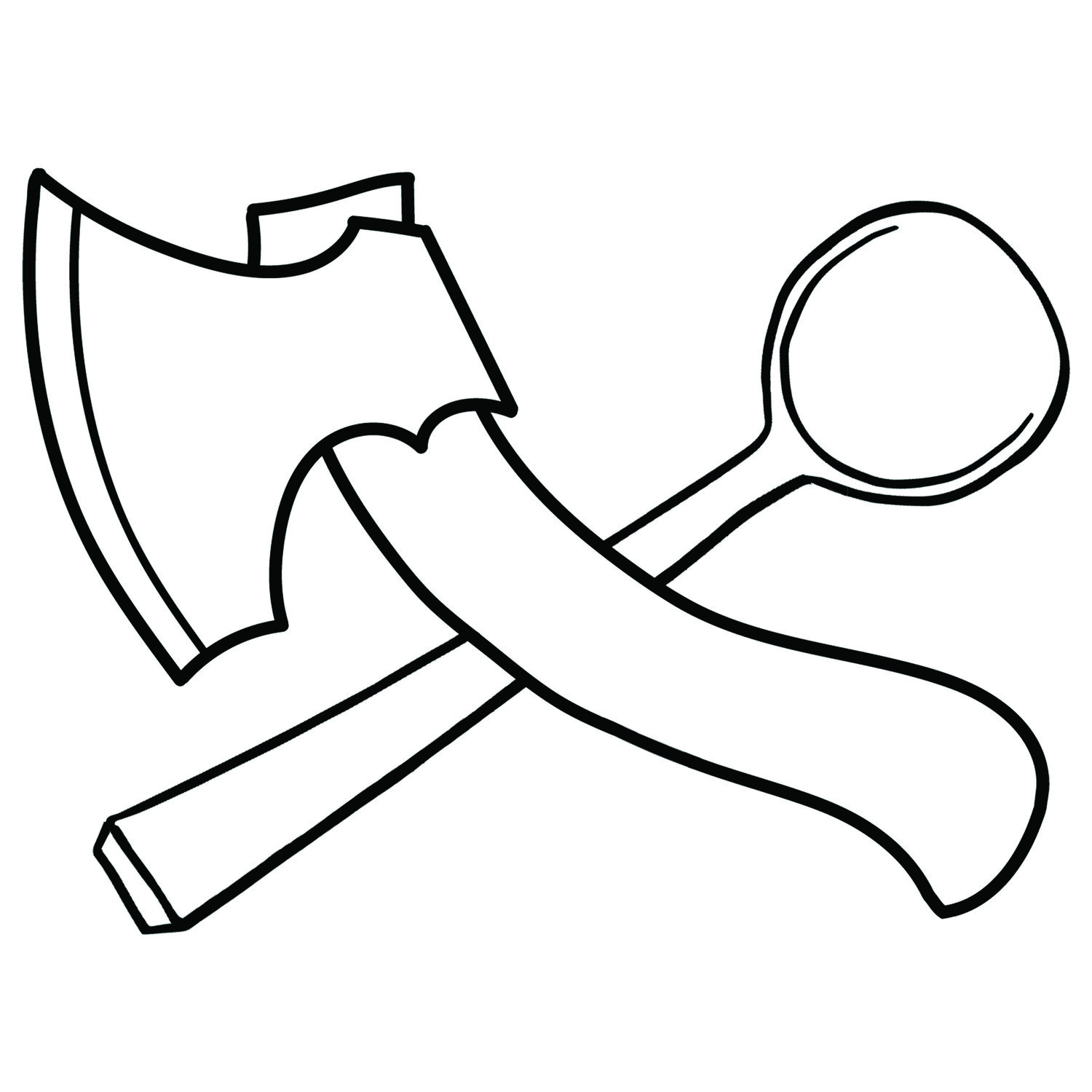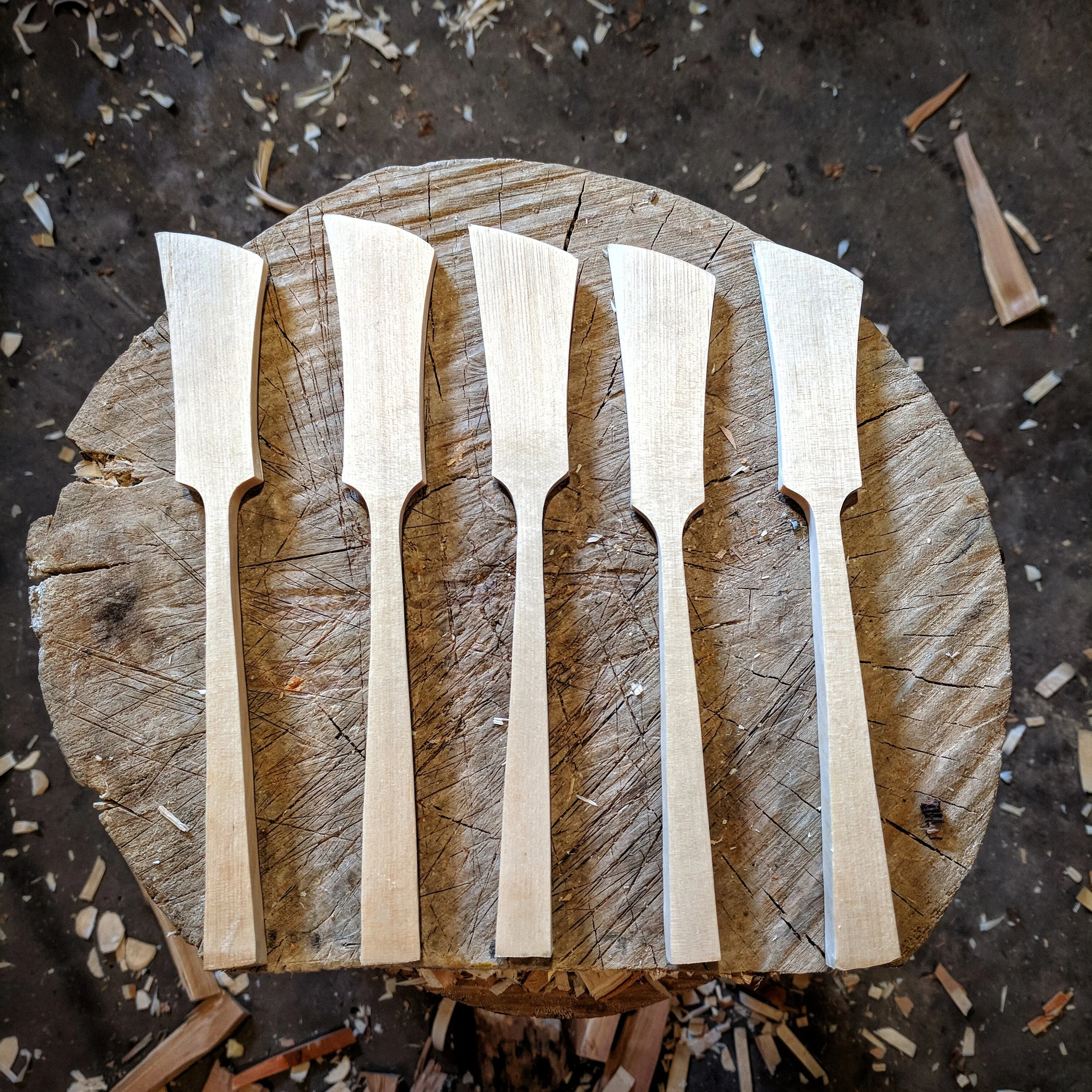The Four Kinds of Copying
Apprenticeship Day Two
Today was a similar day to yesterday. Jarrod worked on finishing the cooking spoons I roughed out yesterday. I roughed out spatulas ready for finishing cuts and did the basic axe work on some eating spoons. All of the items we're working on at the moment will be part of a shop update Jarrod will be doing around Thanksgiving. If you want to know the exact time and date to snag yourself a 10% discount, sign up to Jarrod's newsletter.
The main difference today was Jarrod having me do some knife work on the spatulas. Working to one Jarrod made, I refined the plane view, trying to get as close to the original as possible. This was partly to give me a rest from the more physical axe work. It was also a good opportunity to see how subtle changes in a design change the overall appearance. For some I made the top too wide. On it's own that's fine, by in conjunction with how the blade transitions to the handle, it throws off the balance and lines that Jarrod has developed.
I was going to do a fun little Instagram post using the below image. I wanted to add a letter A-E above each spatula and have my followers guess which is the original carved by Jarrod. In face I issued the same challenge to Jarrod. He had two main advantages: he already knew what the original looked like and was able to hold the spatulas. He umm'd and ah'd between two for a little bit, but selected the correct one fairly quickly.
Which do you think is Jarrod's?
However there's recently been a bit of hubbub in the spoon carving community over accusations of copying. One gentleman accused another of copying his work. It all got a little heated, as digital debates have a habit of doing. Of course, this controversy, and the wider subject of copying has been a topic of conversation for Jarrod and myself.
I didn't want to publish the post I outlined above as my intention for it wasn't to be a part of the dialogue into copying and I knew that's how it would likely go.
That said I did want to put down a few of my thoughts on the issue of copying. As I see it there are four ways copying occurs:
1. Unconscious inspiration
2. Conscious inspiration
3. Unconscious replication
4. Conscious replication
They're clearly related, and I'm sure grey zones exist between them. A theme that runs through them is intent. This is something Jarrod talked about with me. What is someone trying to do when going through one of these processes?
Unconscious Inspiration
This is the most common form of copying Many craftspeople look at lots of example of work that's similar to their own. I have a Pinterest board with over a thousand pictures of spoons on it. I own dozens of spoons from other makers. Almost everyday I look at pictures of woodworking. All that exposure is likely to find it's way into my work. If I carve a spoon I might look at the wood and think a certain handle shape will work well with the grain. That handle might be from a maker whose work I've seen. I might pair that handle with a bowl I saw a different maker use. I could even top if off with some decoration inspired by a third maker. This would all be done without consciously linking those design elements to the originals. This is the least likely to offend as the work is likely to end up looking quite different from the original sources. Along the way I would have added my own changes. If someone thinks my item has ended up looking like another persons work, I can be confident that it was never my intention to do that, and the thought of copying work wasn't in my mind.
Conscious Inspiration
This involves making the conscious decision to make an item in a style another maker is known for. It could be wanting to make your own cawl spoon because you've seen one of Owen Thomas', or trying asymmetric bowls because you like the way Adam Hawker uses them. Or, similar to the above example, you could consciously think of design elements from other makers and combine them in your work. You've made something new, but the inspiration came from others. Depending on the context of how your work is being shown, you might mention the inspiration, you might not. For inspiration I think either is fine. If someone comments that your work reminds them of the maker who inspired you, then it would be prudent to acknowledge where the design inspiration comes from.
Unconscious Replication
This is when you carve a spoon that, in it's entirety, looks very similar to someone else's work. However that wasn't your intention to do so when you set out. This happened to me recently, and I was only realised it because of some work I put into to figuring out where the original design came from.
I was carving the above spoon. A similar spoon is featured in the book 'Spon' by Barn the Spoon. I own a copy of the book, and I know Barn. He's a fantastic spoon carver. But I'd been carving feather spoons for ages. Way before the book came out. Part of me wanted to post the image without accrediting Barn, because I've been doing this design on and off for a few years. Sure Barn published this design, but I certainly didn't learn it from his book.
So I set about going through old photos to try and find my oldest feather spoon. What I discovered made me laugh. I'd been carving feather spoons since 2014. When I went to Skedfest. Where I saw Barn carve a feather spoon. Oops.
I had completely forgotten where I got that design from. To the extent I was almost ready to believe it was my own creation. If i didn't have my photo record as a reminder I might never have remembered. This form of copying can be very quarrelsome. I might genuinely believe my work is original, even when shown example that suggest otherwise. I might not be willing to back down from my position because I honestly believe the work to be my own creation.
One of the Seven Sins of Memory is misattribution. We remember something, but we forget how or where we learnt it. It happens to everyone. You tell someone a joke only for them to remind you it was they who told you the joke in the first place. However, unconscious replication is sometimes used as an excuse to cover the last form of copying.
Conscious Replication
This is seeing an object and copying it. This can be an extremely useful learning tool. Today I copied Jarrod's spatula five or six times. The more i did it, the closer I got to replicating the original. The copies that were less perfect served as lessons highlighting when proportion, shape and curves don't work together. Repetition is really important in learning the skills of woodworking with hand tools. By copying Jarrod's spatula several times I now have a better understanding of its design features than if I had just spent the same amount of time looking it. I don't think anyone in the craft world has a problem of others copying their work as a way to gain more skill as a maker. I think very few makers have a problem with their work being copied in general. So long as it's made clear that the work is derivative.
Imitation is the sincerest form of flattery
- Charles Caleb Colton
The darker side of conscious replication is when someone undertakes it but attempts to pass the work as their own, original design.
Replication definitely occurs in the craft world. Whether or not the replication is conscious or unconscious is difficult to prove. However it's something that happens and needs to be acknowledged. Replication without giving credit to where that design came from needs to be discouraged.
Jarrod and I will continue to discuss copying in all it's forms. We might also do a little experiment into it. As usual, I'll be sure to share our thoughts and findings here.
In the meantime, let's keep carving.

